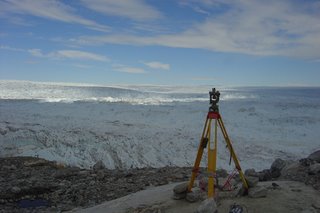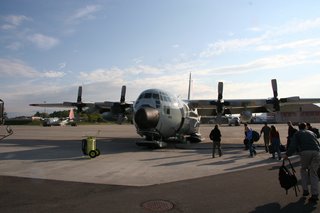The first week in camp was hectic. We were busy establishing camp, further testing our equipment, and deploying the instruments. During the next few weeks there was a lot of down time, except during the few remaining days that we spent relocating GPS stations. All that was left to do was to download the weather station and ablation meter data, check on the cameras, download data from two GPS that were radio-linked to camp, and survey the mirrors every three hours (regardless of time or weather).
The two radio-linked GPS stations malfunctioned after 4 days (bummer) and a major calving event sent two of our mirrors to the bottom of the fjord (bummer). One of the surveying mirrors was now located on an iceberg and could be viewed from camp – by surveying its vertical position and estimating melt rates and tidal range from our tide gauge, we hope to be able to estimate the amount of melting that occurs below the water surface. I started surveying it once every hour, except during my sleeping hours. Others surveyed it while I was sleeping, so we ended up with a pretty nice record. (The astute reader might note that nowadays surveyors tend to use automatic instruments that do everything for you – we couldn’t afford to buy anything newer so we are still using surveying equipment from the 70s. That’s okay though, because the old surveying instruments are beautiful tools and fun to use.)
We brought most of our food with us when we first set up camp, but were occasionally resupplied with very good bread and cheese (Danish colonization isn’t an entirely bad thing…) and even a pineapple. The pineapple was a wonderful surprise. It made up for the fact that Roman accidentally brought several kilograms of muktuk (whale blubber) from Ilulissat, thinking that it was some sort of white fish. Muktuk tastes kind of like greasy leather. Actually I thought it was okay in small quantities, but not as a full dinner.

The lack of things to do, the repetitive nature of surveying the markers and the sun travelling in circles through the sky gave a sense of timelessness. Soon my schedule was nearly flipped upside down.
I had a lot of time to think – sometimes too much. Thinking was something that I hadn’t been able to do much of lately. And I mean really think. What am I doing with my life? Onko suomea vaikea kieli, vai olenko vain laiska? (Is Finnish really a difficult language, or am I just lazy?) Why is this glacier so messed up?

We also passed the time taking hikes, reading books, processing data, playing cribbage, watching the icebergs move past, and seeing how many mosquitoes we could swat with one swing. Martin set the record: 21 killed with just one slap on his arm.












